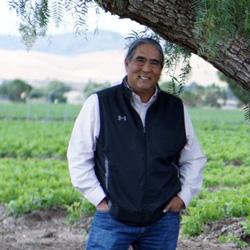Expert: Innovative Ideas, Tech Spur Sustainable Urban Ag

Innovative ideas are spurring the growth of sustainable farming in urban areas and giving growers around the world new ways to produce food, an expert said.
From rooftop gardens to vertical production systems, farmers are maximizing urban spaces and employing new technology for growing crops, third-generation Orange County farmer A.G. Kawamura said during a presentation at Cal Poly Pomona.
“It’s really important that our imagination is hooked into our understanding of what is possible. You put on a different set of glasses and your vision changes,” he said. “We have a different set of glasses on right now in the year 2018, and there’s a lot of things that are possible.”
Kawamura, who was the California secretary of food and agriculture from 2003 to 2010, was the inaugural speaker for the Huntley College of Agriculture’s Sustainable Urban Agriculture speaker series on Nov. 13 at AGRIscapes. The series is part of a new initiative by the college on sustainable urban agriculture, which includes a new minor in urban and community agriculture that launched in this fall.
Vertical farming systems – where plants are grown in stacked pots or planters – date back to the Hanging Gardens of Babylon, one of the seven wonders of the ancient world, Kawamura said.
In recent years, it’s made a comeback and farmers are using the innovations to grow crops. For example, more than 60 percent of vine-ripened tomatoes in North America are grown in indoor houses, Kawamura said.
“We’re not measuring production by the square foot, we’re doing it by the cubic foot,” he said. “A lot has happened in a short amount of time because new technology is now coming online.”
A Canadian company known as Omega Gardens has created a rotary hydroponics system that grows plants in a barrel around a light source, Kawamura added. The plants grow faster because they have to fight against gravity when the barrel is rotated, he said.
The barrels can be stacked into systems that look like cans inside a soda machine: growers can harvest one barrel, while another is planted.
Major grocery companies are using these systems to grow lettuce, microgreens and other plants next to their distribution centers, Kawamura said.
“They’re grown indoors, harvested that day, on the shelf that day in the middle of Minnesota, in the middle of winter,” he said. “Is this the system of the future? Absolutely. It’s happening and industry professionals are just trying to find the right numbers to make it work.”
Others, like Kawamura, are thinking outside the box and finding nontraditional places to farm. Although Orange County evokes images of sprawling suburbs, Kawamura’s company has leased land under utility power lines and from cities, school districts, and universities for his farming operations.
The nonprofit organization that A.G. has partnered with, Solutions for Urban Agriculture, is even growing crops next to the runways of the former Marine Corps Air Station El Toro as part of an interactive urban agricultural showcase for the Orange County Great Park.
“Our goal is to grow all 400 or 500 crops that are grown in California in one place,” Kawamura said.
But sustainable urban agriculture has its limitations and risks.
Indoor crops are still vulnerable to diseases, Kawamura said. Computer glitches and hackers can take down the technological components, while earthquakes can destroy indoor facilities, he said.
Urban farmers need to find enough markets to make their businesses viable, while innovators at startups sometimes struggle to develop new technologies. Like new restaurants, many urban agriculture startups fail, Kawamura said.
“Whether you’re an early adopter or an early innovator, you pour a lot of money into trying to figure out how to get it right,” he said, “and a lot of times you run out of capital or your investors pull the money out from under you.”
Moreover, sustainable urban agriculture systems can’t feed the entire world, Kawamura said. No one should believe that they don’t need farmers anymore just because they have their own little garden, he said.
Rooftop gardens in Chicago, for example, can produce a lot of food, but their growing season is abbreviated by the seasons and climate, Kawamura said.
“Do the math. Seven billion people eating two meals a day, let’s say, times 365 days a year,” he said. “That’s several trillion episodes of them putting something in their mouth. Not everybody is going to be able to go
Instead, sustainable urban agriculture systems can help reduce the vulnerabilities of existing food systems created by climate and uncertain water supplies, he said. They can help countries meet the United Nations Sustainable Development Goals, which aim to promote prosperity around the world while protecting the planet, Kawamura added.
About half of the goals have a lot to do with agriculture, he said.
“If we could accomplish these various goals by the year 2030, the world would be different,” Kawamura said. “Half of the challenges and things we’ve been dealing with, just wouldn’t be there.”
But reaching these goals requires the collective will to do so, he said. To be successful, farmers need support from government agencies and a public that seems to take its food supplies for granted, Kawamura said.
“Successful agriculture sustains civilization,” he said.
The Huntley College of Agriculture plans to host multiple events throughout the year in the Sustainable Urban Agriculture Speaker Series. Details will be announced at a later date.
